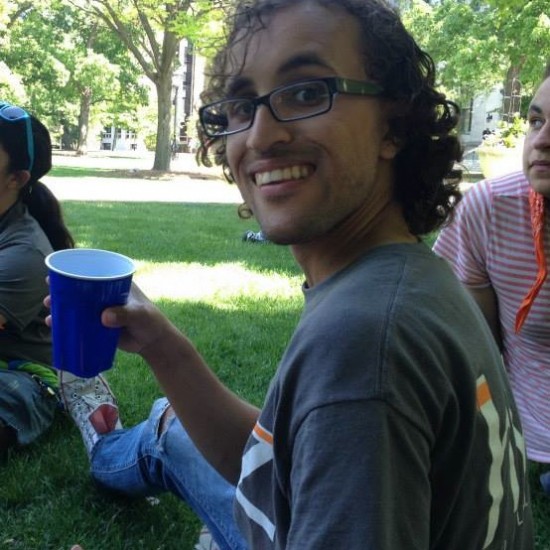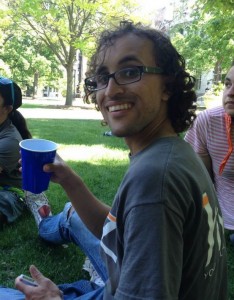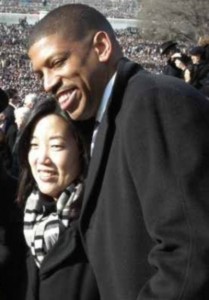My thoughts on Multi Racial identity throughout my college experience are still shifting, as this is written three weeks after my graduation from Chicago. In the infamous words of Zhou Enlai, “It is too soon to tell”[1]. Regardless, there were some definitive changes on campus that were apparent as soon as I arrived. The major was a demographic shift in terms of race and class. Upper class and white individuals now made up the majority of my immediate peer group, perhaps for the first time in my life. I was told that College was a time in which I was supposed to be pushed out of my comfort zone, so I supposed engaging in a very different aspect of society was part of that general shift.
There is, however, a distinction between feeling uncomfortable, and feeling threatened, and it was between these two feelings that I spent a majority of my time at Chicago. When I say I felt “threatened”, I should probably clarify. This wasn’t necessarily feeling threatened by physical violence—it was feeling threatened by a general sense of bad faith, and poor concern. While it has become a standard complaint that college campuses are hotbeds of “political correctness” that threaten the very essence of “academic freedom”, I would assert there being a difference between stifling discussion, and making discussion bearable for minority individuals of all demographics. A prime example of this was during our Orientation Week, which is the first week that first years are on campus. A series of exercises were designed to get students to “think” about their conceptions of race. One such exercise (and these have changed since my year): you’re walking alone late at night, and you see two black males walking towards you. Do you cross the street? Little discussion was actually had on the point.
The University had the awkward job of attempting to efficiently maintain boundaries, while not appearing racist. So, with one hand, they loosely offered support to minority communities of race, gender and class, while the other tugged on the strings of the UCPD, racially profiling people on campus to ensure that, in particular, African Americans not part of the UChicago community spent as little time on campus as possible. I remember being told to stay away from certain transit lines, as I would die if I took them.
Things get interesting when we remember that Chicago, as a university, is structurally a Western creation, and this made transitions for non-Western groups incredibly difficult. I can only speak to the Chicago experience, and only of my perspective on that experience, but there appears to be occasional moments in which similar frustrations have been expressed. The Black Bruins’ spoken poetry last year[2] and Alok Vaid-Menon’s “Break-Up Letter with Stanford”[3] both speak to this tension of maintaining one’s sanity, while having feet both in a part of the hierarchy created, and as an outsider. If we read people like we do texts, then the role of a University is to produce people who can be read as marked by Reason, with a capital R. The sort of Reason that one might expect from a Western Enlightened institution.
Chicago may have been a slightly better place in the sense of coming to terms with its origins in this regard. As a friend of mine once remarked: “At UChicago, you’re only as good as your last argument”. In theory, this sounds like the brilliant beginning of a serious engagement with a post-racial world, and I would like to believe it was. On the other hand, there was a definitive double standard for the theories that pointed out the need for multicultural engagements. I’ve seen and heard more than one classmate in this regard refer to the academic projects of provincializing the West as “bullshit”. In this regard, we might say the transition to college included a reflexive aspect of inquiry, one that might even be said to challenge the empirical realities of a student’s past.
We might say this if it wasn’t for the fact that white hierarchy was shown, again and again, to reject the offerings of diversity and discourse. This may seem like a radical claim, but it is difficult to shy away from when one considers how, year after year, another series of incidents occur to de-stabilize the utopian racial harmony construction that diversity was supposed to engender. One year, it was African Americans being body slammed in our main library[4]. Another year, it was a party entitled “Conquistador Bros and Aztec Hos”[5]. Despite Asians only making 16% of the College, there was a constant barrage of whispers about how there were “so many Asians”, which of course, discounted the South Asian demographic. During my second and third years, a variety of anonymous sub forums would reveal the drastic difference in how individuals perceived race—some going so far as to suggest African Americans ought to be removed from the University, and that Hitler might not have had the worst ideas.
Of course, one might defend the College experience by claiming “not all white people” or “not all men” whatever the category in question may be. However, that such vitriol existed is enough to suggest that the navigation process was extraordinarily different than the one that had existed in high school. When I invoked “threatened” I meant that, at certain points, I was no longer sure how much I could actually trust classmates.
The worst aspect of this environment was that it fell upon minority voices to offer pushback on most of these issues. What had been billed as “diversity” actually entailed minorities on all fronts to defend their rights to exist. And at times, this included opposition from the University itself. Thus, when someone like Sy Stokes says “Because our faces are just used to cover up from the public what’s really inside//Revitalizing lies to perpetuate your disguise//Stop pretending that the wounds of our past have healed”, one might imagine how this could resonate with a larger population than simply students within UCLA.
This was what I meant when I earlier stated that the failure of early humanities education on a whole made the diversity project harder. Rather than having a basic sense about how the past influenced the present, and how racial structures permeate through time, to the present, it was easier for people coming from privileged backgrounds first experiencing other groups to deny there was anything wrong with society. Eighteen years of structural validation meant that transforming perspectives on the relationship between empirical and conceptual race-thinking was much harder than it should have been. This was best illustrated by an unwillingness, for example, to acknowledge the backhandedness of a comment like “you speak so well for someone of your culture”. To challenge the authority of the cultural hegemony laid down by racial hierarchy was to challenge everything a majority of the College had experienced up to this point.
Combine this with a deep commitment to the Marxist tradition at the time—the elimination of class would eliminate other sources of social struggle—and you understand why I did not initially desire to engage my classmates on issues of race. Part of this was a deep desire to believe that society was structurally fine, and that our problems were based in a couple of unintelligent people who would never amount to anything politically relevant. However, the longer I remained in the College, the more I realized that Arendt’s diagnosis of Eichmann was equally applicable to most of my classmates, in some regard. Darin Strauss best expressed what I mean in his use of Arendt during the Paula Deen scandal:
“ In Arendt’s most famous book, Eichmann in Jerusalem: A Report on the Banality of Evil, she argued that sometimes what we call evil — and what can bring about the most horrible outcomes — can often more accurately and simply be thoughtlessness of a sort…
…Again, Arendt was perhaps the first to write coherently about the trouble communities have in seeing the world as being something other than what they have been conditioned to see — without any kind of cultural empathy.”[6]
If we take this suggestion with some merit, then it appears as though the role of college diversity is to inject this cultural empathy that had been lacking for so long from my classmates’ experiences. Yet, this completely ignores the fact that this conditioning is also operative for the sources of diversity that are expected to maintain cool, calm and collected in the face of comments, microaggressions and queries that make us re-evaluate our role in these schools on a day-to-day basis.
I would like to end this story, coming full circle. I started with the empirical facts of my race, and the conceptual aspects assigned to me by my peers in kindergarten. One of the points of college is to escape from parental units, and looking at one’s life without the shadow of constant adult supervision. In my case, this meant being removed from the most powerful reinforcement of my white identity—my mother. I didn’t see it in this way until much later—as Vaid-Menon wrote, “your parents – called it ‘becoming an adult’ but you called it staying out past your bedtime dancing, called it holding his hand on the street, called it safe, and sometimes even freedom”.
It was late one night, after a study session in our main library, and I was heading back to the dorm, during winter. I had a large North Face jacket, the sort with fur around the hood, which was up because Chicago winter. I had been walking briefly, when I saw a friend walking towards me, somewhere ahead of me. I went to shout a greeting, but before I could, he stepped back and crossed the street. I don’t know if he recognized me, or if he just saw a large hooded jacket headed towards him. There could be any number of reasons this occurred, but I think one would be a fool to not consider the reality of the situation. I had begun with an identity that was completely maintained in the sphere of White, and ended with experiences that rapidly placed me into Black.
I wasn’t quite sure how to react, so I didn’t, and I’ve quietly born the experience alongside the many others I have had as I watched other people balance where I do or do not live, and what claims I do or do not get to make. Even now, I get the random email or message from some person or another questioning about what right I have to appropriate racial experiences.
I am still unsure if I have mapped out exactly what I wanted to bring to the discussion about Multi Racial identity. My basic point is to illustrate the power society yields in the deployment of conceptual categories in regards to race, and what Multi Racial bodies have to do in order to navigate those politics, for where there is power, there is certainly a set of politics that guide how that power is used. And it is through the careful engagement of these navigations that we may be able to formally create spaces in which Multi Racial subjects of all backgrounds may feel comfortable laying claim to all engagements of this social power, since the way people perceive us is incredibly dynamic and dependent on a variety of factors beyond our control.
[1] This is typically attributed to a question about the French Revolution, but increasingly it appears as though he were under the impression that the question was about the revolts of 1968: http://www.historytoday.com/blog/news-blog/dean-nicholas/zhou-enlais-famous-saying-debunked?ip_login_no_cache=cd84e3312dd0f3dcf3c621eedcb4d701 .
[6] Darin Strauss, “The Banality of Butter: What Hannah Arendt Can Tell us About Paula Deen”: http://www.thewire.com/national/2013/07/banality-butter-what-hannah-arendt-can-tell-us-about-paula-deen/66737/ .
By: July 2014 Guest Blogger- Marley-Vincent Lindsey
Marley-Vincent Lindsey is a freelance writer and independent researcher located in New York. He recently graduated from the University of Chicago with a degree in history and is primarily interested in 16th century Colonial Spain, the influence of Christianity on colonial institutions, subaltern studies and postcolonial theory and the relationship between digital media and history. He will be presenting at the Sixth Annual Conference on Power and Struggle hosted by the University of Alabama, and is publishing a paper entitled “The Politics of Pokémon: Socialized Gaming, Religious Themes and the Construction of Communal Narratives” in the forthcoming volume of Heidelberg Journal of Religions on the Internet. When he’s not on the academic grind, he’s probably playing Starcraft and other related strategy games, skating or thinking about contingency plans for the zombie apocalypse. He can be contacted via email (mvlindsey92@gmail.com) or through his notebook-blog (mvlindsey.wordpress.com). He also really likes cats.
(due to an abundance of spam, we’ve had to turn off comments here, but please head over to our Facebook page – we’d love to hear and share your thoughts there! facebook.com/MixedRootsStories)



